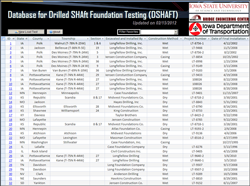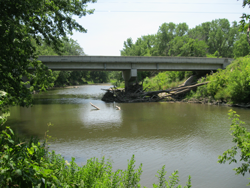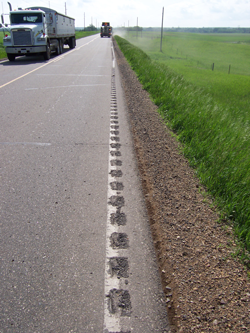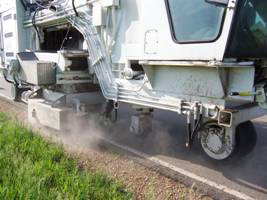Project Details
09/04/09
07/25/12
Federal Highway Administration
Researchers
James E. Alleman
John T. Kevern
About the research
This research effort evaluated the environmental impacts and benefits obtained from concrete paving materials blended with photo-chemically-active titanium dioxide (TiO2). The project was completed in combination with a full-scale Missouri Department of Transportation (MoDOT) two-lift paving demonstration project in the St. Louis, Missouri urban area. Two innovative photo-catalytic concrete paving materials have been studied during this project, including: a) a photocatalytic concrete mainline pavement and b) a photocatalytic pervious concrete shoulder pavement. The mainline pavement material was applied using a two-lift paving strategy, where the lower, base-level layer was constructed with less expensive materials (e.g., a low cementitious-content base lift), and the thinner top wearing course was then overlaid immediately with concrete containing photocatalytically active cement. The included photocatalytic concrete paving material is marketed under the trade-name TX Active. The second shoulder pavement element involved a similar, photocatalytic concrete material also containing the titanium dioxide additive, although in this instance the TiO2 was blended into a pervious (rather than conventional) concrete for the roadside shoulder pavement material. Together, this set of innovative mainline and shoulder paving materials, including both a two-lift photocatalytic mainline pavement and a photocatalytic pervious shoulder pavement, is believed to represent one of the most technically advanced and environmentally-friendly concrete pavement systems ever employed in the US. Field-scale assessment of this innovative highway involved both passive and active air quality NO and NO2 testing, respectively using integrative Ogawa samplers and a 2B Technologies ozone titration analyzer. This field-scale assessment also involves water-quality testing of mainline and shoulder pavement runoff.
Project Details
08/26/09
07/25/12
Federal Highway Administration
TPF-5(117)
Researchers
Paul Tikalsky
About the research
Supplementary cementitious materials (SCM) have become common parts of modern concrete practice. The blending of two or three cementitious materials to optimize durability, strength, or economics provides owners, engineers, materials suppliers, and contractors with substantial advantages over mixtures containing only portland cement. However, these advances in concrete technology and engineering have not always been adequately captured in specifications for concrete.
Users need specific guidance to assist them in defining the performance requirements for a concrete application and the selection of optimal proportions of the cementitious materials needed to produce the required durable concrete. The fact that blended cements are currently available in many regions increases options for mixtures and thus can complicate the selection process. Both portland and blended cements have already been optimized by the manufacturer to provide specific properties (such as setting time, shrinkage, and strength gain). The addition of SCMs (as binary, ternary, or even more complex mixtures) can alter these properties, and therefore has the potential to impact the overall performance and applications of concrete.
This report is the final of a series of publications describing a project aimed at addressing effective use of ternary systems. The work was conducted in several stages and individual reports have been published at the end of each stage.
Project Details
06/22/10
07/25/12
Federal Highway Administration
TPF-5(100)
Researchers
Doug Hooton
About the research
With the use of supplementary cementing materials (SCMs) in concrete mixtures, salt scaling tests such as ASTM C672 have been found to be overly aggressive and do correlate well with field scaling performance. The reasons for this are thought to be because at high replacement levels, SCM mixtures can take longer to set and to develop their properties: neither of these factors is taken into account in the standard laboratory finishing and curing procedures. As a result, these variables were studied as well as a modified scaling test, based on the Quebec BNQ scaling test that had shown promise in other research.
The experimental research focused on the evaluation of three scaling resistance tests, including the ASTM C672 test with normal curing as well as an accelerated curing regime used by VDOT for ASTM C1202 rapid chloride permeability tests and now included as an option in ASTM C1202. As well, several variations on the proposed draft ASTM WK9367 deicer scaling resistance test, based on the Quebec Ministry of Transportation BNQ test method, were evaluated for concretes containing varying amounts of slag cement. A total of 16 concrete mixtures were studied using both high alkali cement and low alkali cement, Grade 100 slag and Grade 120 slag with 0, 20, 35 and 50 percent slag replacement by mass of total cementing materials. Vinsol resin was used as the primary air entrainer and Micro Air® was used in two replicate mixes for comparison.
Based on the results of this study, a draft alternative test method to ASTM C762 is proposed.
Project Details
10-366, SPR 90-00-RB01-010
02/01/10
06/30/12
Federal Highway Administration
Iowa Department of Transportation
Researchers
Jessica Garder
About the research
Drilled shafts have been used in the US for more than 100 years in bridges and buildings as a deep foundation alternative. For many of these applications, the drilled shafts were designed using the Working Stress Design (WSD) approach. Even though WSD has been used successfully in the past, a move toward Load Resistance Factor Design (LRFD) for foundation applications began when the Federal Highway Administration (FHWA) issued a policy memorandum on June 28, 2000.The policy memorandum requires all new bridges initiated after October 1, 2007, to be designed according to the LRFD approach. This ensures compatibility between the superstructure and substructure designs, and provides a means of consistently incorporating sources of uncertainty into each load and resistance component.
Regionally-calibrated LRFD resistance factors are permitted by the American Association of State Highway and Transportation Officials (AASHTO) to improve the economy and competitiveness of drilled shafts. To achieve this goal, a database for Drilled SHAft Foundation Testing (DSHAFT) has been developed. DSHAFT is aimed at assimilating high quality drilled shaft test data from Iowa and the surrounding regions, and identifying the need for further tests in suitable soil profiles.
This report introduces DSHAFT and demonstrates its features and capabilities, such as an easy-to-use storage and sharing tool for providing access to key information (e.g., soil classification details and cross-hole sonic logging reports). DSHAFT embodies a model for effective, regional LRFD calibration procedures consistent with PIle LOad Test (PILOT) database, which contains driven pile load tests accumulated from the state of Iowa. PILOT is now available for broader use at the project website: http://srg.cce.iastate.edu/lrfd/. DSHAFT, available in electronic form at http://srg.cce.iastate.edu/dshaft/, is currently comprised of 32 separate load tests provided by Illinois, Iowa, Minnesota, Missouri and Nebraska state departments of transportation and/or department of roads. In addition to serving as a manual for DSHAFT and providing a summary of the available data, this report provides a preliminary analysis of the load test data from Iowa, and will open up opportunities for others to share their data through this quality–assured process, thereby providing a platform to improve LRFD approach to drilled shafts, especially in the Midwest region.
Researchers
Terry Wipf
About the research
Debris accumulation on bridge piers is an on-going national problem that can obstruct the waterway openings at bridges and result in significant erosion of stream banks and scour at abutments and piers. In some cases, the accumulation of debris can adversely affect the operation of the waterway opening or cause failure of the structure. In addition, removal of debris accumulation is difficult, time consuming, and expensive for maintenance programs.
This research involves a literature search of publications, products, and pier design recommendations that provide a cost effective method to mitigate debris accumulation at bridges. In addition, a nationwide survey was conducted to determine the state-of-the-practice and the results are presented within.
Researchers
Neal Hawkins
hawkins@iastate.edu email >Director Research Administration, ISU
About the research
The objective of this project was to promote and facilitate analysis and evaluation of the impacts of road construction activities in Smart Work Zone Deployment Initiative (SWZDI) states.
The two primary objectives of this project were to assess urban freeway work-zone impacts through use of remote monitoring devices, such as radar-based traffic sensors, traffic cameras, and traffic signal loop detectors, and evaluate the effectiveness of using these devices for such a purpose. Two high-volume suburban freeway work zones, located on Interstate 35/80 (I-35/I-80) through the Des Moines, Iowa metropolitan area, were evaluated at the request of the Iowa Department of Transportation (DOT).
Project Details
01/25/10
01/05/12
Federal Highway Administration
Researchers
Tom Van Dam
About the research
The result of this project will be a manual of practice that will educate practicing engineers about sustainability as it is applied to concrete pavements. This document will be a product of the Sustainability Track (Track 13) of the Long-Term Plan for Concrete Pavement Research and Technology (CP Road Map).
Researchers
Tom McDonald
About the research
Single-vehicle run-off-road crashes are the most common crash type on rural two-lane Iowa roads. Rumble strips have proven effective in mitigating these crashes, but the strips are commonly installed in paved shoulders on higher-volume roads that are owned by the State of Iowa. Lower-volume paved rural roads owned by local agencies do not commonly feature paved shoulders but frequently experience run-off-road crashes.
This project involved installing rumble stripes, which are a combination of conventional rumble strips with a painted edge line placed on the surface of the milled area, along the edge of the travel lanes, but at a narrow width to avoid possible intrusion into the normal vehicle travel paths.
The research described in this report was part of a project funded by the Federal Highway Administration, Iowa Highway Research Board, and Iowa Department of Transportation to evaluate the effectiveness of edge-line rumble strips in Iowa. The project evaluated the effectiveness of rumble stripes in reducing run-off-road crashes and in improving the longevity and wet-weather visibility of edge-line markings.
This project consisted of two phases. The first phase was to select pilot study locations, select a set of test sites, install rumble stripes, summarize lessons learned during installation, and provide a preliminary assessment of the rumble stripes’ performance.
The purpose of this report was to document results from Phase II. A before and after crash analysis was conducted to assess whether use of the treatment had resulted in fewer crashes. However, due to low sample size, results of the analysis were inconclusive. Lateral position was also evaluated before and after installation of the treatment to determine whether vehicles engaged in better lane keeping. Pavement marking wear was also assessed.
Researchers
Tom McDonald
About the research
Single-vehicle run-off-road crashes are the most common crash type on rural two-lane Iowa roads. Rumble strips have been proven effective in mitigating these crashes, but these strips are commonly installed in paved shoulders adjacent to higher-volume roads owned by the State of Iowa. Lower-volume paved rural roads owned by local agencies do not commonly feature paved shoulders but frequently experience run-off-road crashes. This project involved installing ?rumble stripes,? which are a combination of conventional rumble strips with a painted edge line placed on the surface of the milled area, along the edge of the travel lanes but at a narrow width to avoid possible intrusion into the normal vehicle travel paths.
Candidate locations were selected from a list of paved local rural roads that were most recently listed in the top 5% of roads for run-off-road crashes in Iowa. Horizontal curves were the most favored locations for rumble stripe installation because they commonly experience roadway departure crashes.
The research described in this report was part of a project funded by the Federal Highway Administration, Iowa Highway Research Board, and Iowa Department of Transportation to evaluate the effectiveness of edge line rumble strips in Iowa. The project evaluated the effectiveness of ?rumble stripes? in reducing run-off-road crashes and in improving the longevity and wet weather visibility of edge line markings. This project consists of two phases. The first phase was to select pilot study locations, select a set of test sites, install rumble stripes, summarize lessons learned during installation, and provide a preliminary assessment of the rumble stripes? performance. This information is summarized in this report. The purpose of the second phase is to provide a more long-term assessment of the performance of the pavement markings, conduct preliminary crash assessments, and evaluate lane keeping. This will result in a forthcoming second report
Project Details
Work Plan 20
09/04/09
09/03/11
Federal Highway Administration
Researchers
About the research
This research investigated the effects of changing the cementitious content required at a given water-to-cement ratio (w/c) on workability, strength, and durability of a concrete mixture.
An experimental program was conducted in which 64 concrete mixtures with w/c ranging between 0.35 and 0.50, cementitious content ranging from 400 to 700 per cubic yard (pcy), and containing four different supplementary cementitious material (SCM) combinations were tested. The fine-aggregate to total-aggregate ratio was fixed at 0.42 and the void content of combined aggregates was held constant for all the mixtures. Fresh (i.e., slump, unit weight, air content, and setting time) and hardened properties (i.e., compressive strength, chloride penetrability, and air permeability) were determined.
The hypothesis behind this study is that when other parameters are kept constant, concrete properties such as strength, chloride penetration, and air permeability will not be improved significantly by increasing the cement after a minimum cement content is used.
The study found that about 1.5 times more paste is required than voids between the aggregates to obtain a minimum workability. Below this value, water-reducing admixtures are of no benefit. Increasing paste thereafter increased workability. In addition, for a given w/c, increasing cementitious content does not significantly improve compressive strength once the critical minimum has been provided. The critical value is about twice the voids content of the aggregate system. Finally, for a given w/c, increasing paste content increases chloride penetrability and air permeability.




